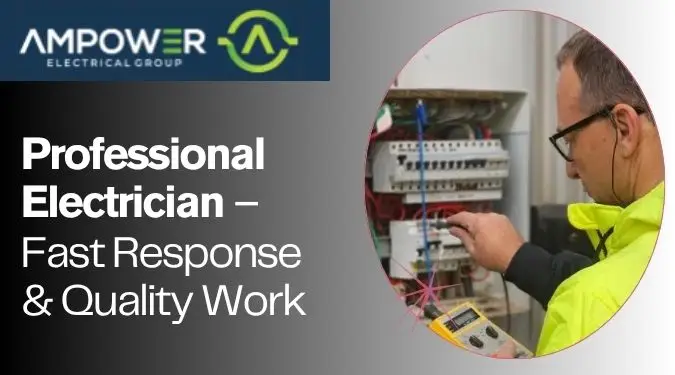Power interruptions can be confusing, especially when lights start flickering or go out completely. Many homeowners get caught off guard, unsure what’s happening or what to do next. Whether it’s a sudden blackout or a gentle dimming known as a brownout, both can affect your home’s electrical safety. Understanding the difference helps you protect your devices and know when to call an expert.
A professional electrician in Turramurra often handles cases where residents face repeated power dips or total outages. They have the tools and skills to diagnose the issue safely and recommend reliable solutions.
What Is a Brownout?
A brownout happens when the electricity supply drops but doesn’t cut off entirely. Lights may dim, and appliances can run slower or malfunction. Brownouts are usually caused by high demand on the power grid or faults in the supply system.
During a brownout, it’s best to:
- Unplug sensitive electronics like computers or TVs.
- Avoid using heavy appliances until voltage stabilises.
- Call a qualified electrician in Gordon to check for wiring or circuit issues in your home.
Even short brownouts can cause harm to modern electronics, as low voltage affects the internal components. Regular electrical maintenance can prevent long-term damage and reduce such events.
What Is a Blackout?
A blackout is a complete loss of electricity in your area or building. It may last minutes, hours, or even longer, depending on the cause. Blackouts can result from technical faults, severe storms, or power grid failures.
When a blackout occurs:
- Turn off electrical switches to prevent surges when power returns.
- Use battery lights instead of candles for safety.
- Contact an experienced electrician in Pymble if your home stays dark while others regain power.
After a blackout, always check your circuit breakers and give your system a quick inspection before switching major devices back on. Faulty circuits or overloaded wiring can delay recovery unnecessarily.
Primary Differences Between Brownouts and Blackouts
- Power level – Brownouts involve low voltage; blackouts mean total power loss.
- Duration – Brownouts are short and temporary; blackouts can last longer.
- Impact – Brownouts can damage electronics; blackouts stop all electrical use.
- Response – Brownouts call for device protection; blackouts require patience and safety checks.
If you notice dimming lights often, a skilled electrician in Turramurra can test voltage stability and ensure your system’s safety. They can also inspect overloaded circuits to prevent future interruptions.
Stay Safe and Prepared
Power interruptions can be unpredictable, but being aware helps you act quickly and safely. Keep your electrical system in good shape with regular checks and avoid DIY fixes if unsure. A licensed electrician in Pymble can help maintain your home’s safety and prevent damage from voltage changes.
Reach Out to Us
If you ever face a sudden brownout or blackout, our professional electrician is only a call away. At Ampower Electrical Group, we offer prompt service and expert advice to restore electricity safely and keep your home powered without risk. For more guidance or emergency support, contact our team at 1300 267 693 / (02) 9052 0867 for quick and reliable help. Alternatively, you can email us at info@ampowerelectrical.com.au .
FAQs
1. What is the main difference between a brownout and a blackout?
A brownout happens when voltage drops but electricity still flows, causing lights to dim or flicker. A blackout is a complete power loss where all electrical supply stops until restored.
2. Can a brownout damage electronic devices?
Yes. Prolonged brownouts can cause overheating or malfunction in sensitive appliances like computers and televisions due to unstable voltage levels.
3. What should I do first during a blackout?
Turn off major electrical appliances and lights. This prevents potential power surges when electricity returns and protects your home circuits.
4. Why do brownouts usually happen?
Brownouts occur when there’s too much demand on the power grid, or when faulty wiring or overloaded circuits reduce available voltage in your area.
5. How can I protect my home during frequent brownouts?
Installing surge protectors, voltage regulators, and getting regular inspections from a qualified electrician help protect appliances from low-voltage issues.
6. What causes long-lasting blackouts?
Blackouts can result from severe storms, equipment failures, or maintenance work on power lines. Sometimes, wider grid malfunctions extend power loss duration.
7. Who should I call if my power doesn’t return after a blackout?
If nearby homes have power but yours doesn’t, contact a certified electrician to inspect your switchboard, wiring, and circuit breakers for faults.
8. How do I know if I’m experiencing a brownout or wiring problem?
If lights dim across your entire home, it’s likely a brownout. If only one room or outlet is affected, faulty wiring is probable – call an experienced electrician to confirm.
9. Is it safe to use a generator during a blackout?
Yes, but follow proper safety practices. Use generators outdoors, never indoors, and ensure your main power is isolated before connecting appliances.
10. Can regular electrical maintenance prevent future power issues?
Absolutely. Routine inspections by a professional electrician ensure your system remains safe, efficient, and less vulnerable to voltage fluctuations or outages.

